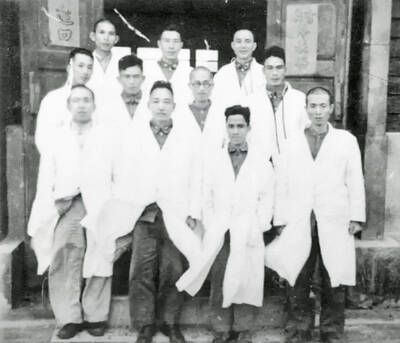Ink painting in Asia has a venerable tradition, but within the world of contemporary art it has been largely sidelined by Western media such as oil and acrylic. Form, Ideas, Essence, Rhythm: Contemporary East Asian Ink Painting (形•意•質•韻 ─ 東亞當代水墨創作邀請展), curated by art historian Jason Wang (王嘉驥), examines the relationship between modern ink painting and traditional Chinese aesthetics, and the conceptual trends that are driving a new generation of artists.
“Within contemporary art, ink painting is often seen as something traditional, and we may even question whether it has the ability to renew itself to reflect modern aesthetic experiences,” Wang said. “Ink painting is still a major tradition within Asian art, and many artists continue to work and teach within the traditional forms of Asian ink painting, but the real dynamism is being shown by individuals outside the mainstream.”
Artist Pan Hsing-hua (潘信華), who teaches art in Hualien, said his students are mainly interested in studying Western art.
“They feel that ink painting is very distant from them, and being distant it is unfamiliar,” Pan said. “This is very sad. They cannot see a connection between ink painting and the world they live in. An exhibition like this may show them that there is in fact great potential in ink painting.”
The 96 works on display, by 25 artists from four countries — Taiwan, China, Japan and South Korea — quickly dispel any idea that ink painting is a thing of the past. These range from the hyper-kinetic manga imagery of Mise Natsunosuke’s My God — Tiananmen (My God — 天安門) to the ultra-minimalismist calm of Yan Shanchun’s (嚴善錞) Searching for West Lake in My Dreams (西湖尋夢).
Chinese artist Xu Bing’s (徐冰) works, which incorporate Chinese calligraphy and include text in characters of his own devising, deconstruct Chinese scholarly ink painting, while Yang Jiechang’s (楊詰蒼) black-on-black series explores the medium of ink in lushly textured monochrome panels.
Buddhist and Daoist iconography are reinterpreted in the works of Lin Ju (林鉅), and echoes of Japanese horror cinema pervade the superficially traditional Nyctalopia (夜盲症) by Fuyuko Matsui.
The work on display is almost bewildering in its range, with far too many permutations to be touched on individually here. While this makes the exhibition exhausting to encompass in a single visit, it also makes a point: ink painting is still very much alive and kicking.
“In most cases, ink painting exhibitions look to the past for their theoretic grounding,” Wang said in a talk introducing the exhibition, which probes the new aesthetics being developed by practicing artists.
Wang said he had purposely rejected organizing the exhibition along national lines, choosing instead thematic categories to investigate the potentialities of ink painting in the contemporary world. “I am not saying that theory must necessarily drive creativity, but ink painting needs to go back to fundamentals and take a serious look at the ideas that contemporary ink painting (in East Asia) is trying to express.”
In all the works chosen by Wang, one can find, though not always easily,
Some connection with traditional ink painting can be found in all the works chosen by Wang, though not always easily. Many of the artists on display have taken this link and traveled to a place very distant from what normally expects from Asian ink painting.
What the exhibition shows above all else is that there are powerful imaginations working within the medium of ink painting today. And it is these artists, who feel a strong sense of affinity with an ancient Asian artistic tradition, yet eagerly embrace the influences of the modern world, who might take ink painting into the next generation as an influential and dynamic art form.

That US assistance was a model for Taiwan’s spectacular development success was early recognized by policymakers and analysts. In a report to the US Congress for the fiscal year 1962, former President John F. Kennedy noted Taiwan’s “rapid economic growth,” was “producing a substantial net gain in living.” Kennedy had a stake in Taiwan’s achievements and the US’ official development assistance (ODA) in general: In September 1961, his entreaty to make the 1960s a “decade of development,” and an accompanying proposal for dedicated legislation to this end, had been formalized by congressional passage of the Foreign Assistance Act. Two

Despite the intense sunshine, we were hardly breaking a sweat as we cruised along the flat, dedicated bike lane, well protected from the heat by a canopy of trees. The electric assist on the bikes likely made a difference, too. Far removed from the bustle and noise of the Taichung traffic, we admired the serene rural scenery, making our way over rivers, alongside rice paddies and through pear orchards. Our route for the day covered two bike paths that connect in Fengyuan District (豐原) and are best done together. The Hou-Feng Bike Path (后豐鐵馬道) runs southward from Houli District (后里) while the

March 31 to April 6 On May 13, 1950, National Taiwan University Hospital otolaryngologist Su You-peng (蘇友鵬) was summoned to the director’s office. He thought someone had complained about him practicing the violin at night, but when he entered the room, he knew something was terribly wrong. He saw several burly men who appeared to be government secret agents, and three other resident doctors: internist Hsu Chiang (許強), dermatologist Hu Pao-chen (胡寶珍) and ophthalmologist Hu Hsin-lin (胡鑫麟). They were handcuffed, herded onto two jeeps and taken to the Secrecy Bureau (保密局) for questioning. Su was still in his doctor’s robes at

Mirror mirror on the wall, what’s the fairest Disney live-action remake of them all? Wait, mirror. Hold on a second. Maybe choosing from the likes of Alice in Wonderland (2010), Mulan (2020) and The Lion King (2019) isn’t such a good idea. Mirror, on second thought, what’s on Netflix? Even the most devoted fans would have to acknowledge that these have not been the most illustrious illustrations of Disney magic. At their best (Pete’s Dragon? Cinderella?) they breathe life into old classics that could use a little updating. At their worst, well, blue Will Smith. Given the rapacious rate of remakes in modern